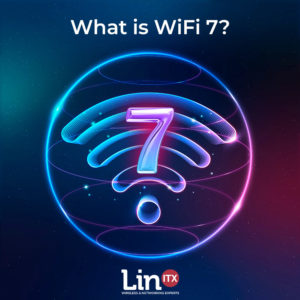
Another day, another advancement in WiFi technology. Here at LinITX, we’re already getting questions relating to the new WiFi 7 standard, so we thought we’d write a LinITX Quick Guide to help customers know the basics.
This new WiFi 7 (802.11be) standard aims to deliver exceptional speeds and efficiency, addressing issues like buffering, lag, or congestion prevalent in previous generations.
WiFi 7 operates across the 2.4 GHz, 5 GHz, and 6 GHz bands, fully utilising the spectrum resources. It’s early days for WiFi 7 right now, with only a handful of products featuring the new standard as of January 2024. Currently LinITX has WiFi 7 product listings for:
Ubiquiti UniFi U7 Pro WiFi 7 Access Point – U7-Pro and
TP-Link Omada EAP773 BE9300 Tri-Band WiFi 7 Access Point
Which both feature the new WiFi 7 standard.
Key Features of WiFi 7
- Increased Bandwidth: WiFi 7 is expected to support 320 MHz channels, doubling the 160 MHz channels of WiFi 6. This increase in bandwidth translates to faster data rates and the ability to handle more simultaneous connections efficiently.
- Improved Quadrature Amplitude Modulation (QAM): While WiFi 6 introduced 1024-QAM, WiFi 7 takes it further with 4096-QAM. This enhancement allows more data to be transmitted with each symbol, significantly increasing throughput.
- Multi-Link Operation (MLO): A groundbreaking feature of WiFi 7 is MLO, which allows devices to transmit data across multiple bands (2.4GHz, 5GHz, and 6GHz) simultaneously. This not only boosts speed and reduces latency but also enhances connection reliability.
- Higher Order MIMO: WiFi 7 is set to support higher-order MIMO (Multiple Input Multiple Output), potentially going beyond the 8×8 MIMO of WiFi 6. This means more data can be transferred at once, improving network efficiency and capacity.
- Improved Latency: With advancements in technology such as Time-Sensitive Networking (TSN), WiFi 7 aims to reduce latency significantly, making it ideal for real-time applications like online gaming, video conferencing, and industrial automation.
WiFi 7 vs. WiFi 6: The Comparison
While WiFi 6 brought considerable improvements over its predecessors, WiFi 7 is designed to take these enhancements to the next level. Here’s how WiFi 7 compares to WiFi 6:
- Speed: WiFi 6 made headlines with its peak data rates of 9.6 Gbps. WiFi 7, however, is expected to triple these speeds, potentially reaching or even surpassing 30 Gbps, marking a new era of ultra-fast internet.
- Capacity and Efficiency: Both WiFi 6 and 7 focus on improving network efficiency and capacity, especially in crowded environments. However, WiFi 7’s MLO feature and higher-order MIMO are set to offer even more robust performance improvements, ensuring stable connectivity even in densely populated networks.
- Latency: While WiFi 6 significantly reduced latency compared to its predecessors, WiFi 7 aims to push these boundaries further, catering to the most latency-sensitive applications.
- Frequency Bands: WiFi 6E introduced the use of the 6GHz band in addition to the existing 2.4GHz and 5GHz bands. WiFi 7 continues this trend and optimises the use of these bands with its MLO feature, ensuring more flexible and efficient spectrum utilisation.
WiFi 7 vs WiFi 6E vs WiFi 6 vs WiFi 5
| Feature | WiFi 5 | WiFi 6 | WiFi 6E | WiFi 7 |
|---|---|---|---|---|
| Max Speed | Up to 3.5 Gbps | Up to 9.6 Gbps | Up to 9.6 Gbps | Expected >30 Gbps |
| Frequency Bands | 2.4 GHz, 5 GHz | 2.4 GHz, 5 GHz | 2.4 GHz, 5 GHz, 6 GHz | 2.4 GHz, 5 GHz, 6 GHz |
| Latency | 35ms | 10 ms | <10 ms | <5 ms |
| MIMO | 4X4 MIMO, DL MU-MIMO | 8X8 UL/D/ MU-MIMO | 8X8 UL/D/ MU-MIMO | 16X16 MU-MIMO |
| Modulation | 256-QAM | 1024-QAM | 1024-QAM | 4096-QAM |
| Channel Bandwidth | Up to 160 MHz | Up to 160 MHz | Up to 160 MHz | Up to 320 MHz |
| Technology | MU-MIMO, OFDM | MU-MIMO, OFDMA | MU-MIMO, OFDMA, TWT | MU-MIMO, OFDMA, TWT, QAM |
If you have any questions relating to WiFi 7, or technical queries on the current range of WiFi 7 products, please call our team of experts on 01449 888000 or email shop@linitx.com
 LinITX Blog Ubiquiti & MikroTik Wireless Networking Experts
LinITX Blog Ubiquiti & MikroTik Wireless Networking Experts




